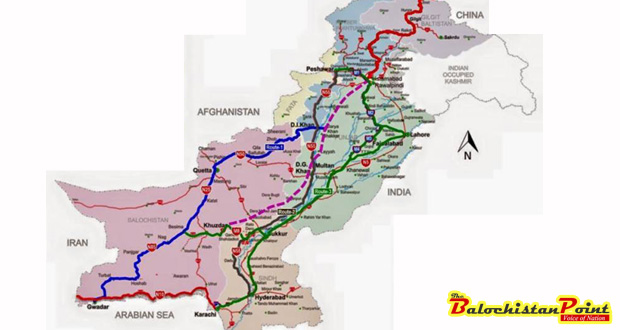Abdul Baseer Khan
China-Pakistan Economic Corridor (CPEC), worth of $46 billion projects, was signed between Pakistan and China in April 2015. The CPEC consists of several projects of Roads, Highways, Expressways and Motorway, Freight Train service, Energy projects, Solar, Windmill and Hydropower, fiber optics and Infrastructure. Besides this, in this economic corridor, there are plans to establish Special Economic Zones (SEZs) in all Provinces to boost economic activities.
No doubt, the economic advantage of the CPEC projects is enormous, it is the reason CPEC is termed as the game changer. Due to this game changer status, each province is striving to get maximum advantage of it, by allocating acres of land for industrial estates and suggesting potential projects. Each Provincial Government is lobbying for incentives attached to the CPEC projects and KP (KP) Government’s recent statement in which they demanded other CPEC associated projects from the Federal Government is an example.
Here, several questions arise relating to CPEC which are needed to be answered. Does road infrastructure bring only development in any region? Will the road networks bring economic development in the province? Who and How many people will be benefit economically from road networks? Do all of the people rely on road side business for their livelihood? Isn’t economic development associated with the purchasing power of the individuals? Besides road networks, what are the associated projects, in CPEC, for the Balochistan Province? How many of the major cities, out of 32 Districts of the Balochistan Province, will benefit from CPEC?
Looking at the current scenario of CPEC, one can arbitrate that for economic activities, the preference of the provinces are to finalize the SEZs as it will generate economic activities in the province. In these SEZs, it is expected that various Private investors and Chinese companies will locate factories. As part of China-Pakistan Economic Corridor, Punjab, Sindh and KP have identified 24 potential sites to develop special economic zones (SEZs), as per media reports, whereas, Balochistan has not shared its SEZ investment sites. KPK government has identified SEZs, secured land, prioritized sectors and recommended industries. KPK government has also forecasted the future investment and the yield in term of job opportunities.
The significance of the corridor can be arbitrated from the working of the Punjab government. In its official presentation to the Federal Government on SEZs, the Punjab government has said that in Sheikhupura, Rahimyar Khan, Bhalwal, Vehari, Chunian, Bahawalpur and Faisalabad, industrial zones are available for investors. Besides this, acres of land have been allocated, for funding opportunities, in the industrial estates of Rawalpindi, Gujrat, Faisalabad, Dera Ghazi Khan, Bhakkar, Shorkot, Jhang, Wazirabad, Okara, Chakwal for potential investors.
The Punjab government has also asked for exemptions on customs duties for initial import of capital goods, machinery & equipment for the establishment of industry, 10 years income tax exemption and dedicated power supply for the SEZs.
Sindh Government has finalized potential locations, for the SEZs, in Karachi, Thatta, Larkana, Jacobabad and Nawabshah. The Sindh government in its presentation to the Federal Government has proposed projects such as the Marble City Project, the Pakistan Textile City and the Chinese Special Economic zones in these SEZs.
Except for the Gwadar, where China has clearly conveyed to the Pakistani authorities that they will develop the Gwadar Port and its SEZ, as priority number one, the Balochistan Government seems to be motionless in identifying SEZs for the Province. Balochistan Special Economic Zone Authority, established under section 10 of the SEZ Act, appeared on the surface in 2013 while searching for its CEO. After the job announcement, it disappeared and since then, it is aimless in attaining the goal of suggesting SEZ for investment opportunities.
Unfortunately, the Balochistan Government, who could have been the biggest beneficiary of CPEC, is silent and seems happy only with the construction of a road network in the western route. The province is economically underdeveloped and majority of its residents is living below the poverty line. Ex-CM Balochistan, Dr. Malik has also accepted this problem and said that people in 29 districts of the province are living below poverty line. In such situation, Balochistan needs special attention to reduce poverty and improve the living conditions. To raise the standards, the province needs economic development, through CPEC associated projects, which will improve the economic wellbeing, rising income level, creating job opportunities and ultimately enhancing the quality of life of the individuals. All these can only be possible when the investment is done in the form of establishing industries and economic zones in the province. Terming roads as the development of the province seems to be a vague statement as it will not alleviate the poverty nor it will create job opportunities for the educated youth. For real economic development there is need of industries or other business opportunities in this province.
Analyzing the future development associated with the eastern route of CPEC, out of 36 districts in Punjab, 17 will be befit in terms of industrial states and SEZs while in Sindh 5 major districts will benefit in term of SEZs. Thus the eastern route will enjoy major investment and projects, providing economic development opportunities, than the western route. It is also worth mentioning here that, the eastern route will benefit from the Motorway and Expressway whereas the western route will get the Highway only. In these circumstances, the statement of CM KPK, Parvez Khattak, seems to be legitimate where he objected on the construction of road and demanded other associated projects.
Published in The Balochistan Point on January 5, 2015
Disclaimer: Views expressed in this article are those of the author and The Balochistan Point not necessarily agrees with them.
 Balochistan Point Voice of Nation
Balochistan Point Voice of Nation




